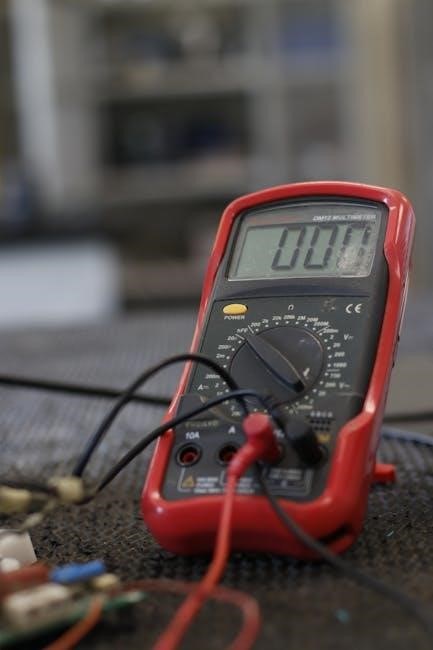
manual vs electric breast pump
Manual and electric breast pumps are essential tools for expressing milk, offering unique benefits. Manual pumps are portable and cost-effective, while electric pumps are faster and require less effort, making them ideal for frequent use. Understanding their differences helps mothers choose the best option for their lifestyle and needs.
1.1 Overview of Breast Pumps
Breast pumps are devices designed to express milk, offering convenience for breastfeeding mothers. Manual pumps are hand-operated, portable, and cost-effective, while electric pumps are powered, faster, and reduce effort. Both types cater to different needs, ensuring efficient milk expression and adaptability to various lifestyles, making them indispensable tools for modern parenting.
1.2 Importance of Choosing the Right Breast Pump
Selecting the right breast pump is crucial for comfort, efficiency, and milk supply maintenance. A suitable pump aligns with lifestyle, frequency of use, and personal preferences, ensuring effective expression and reducing discomfort. The wrong choice may lead to inefficiency or discomfort, impacting breastfeeding success and overall experience for mothers.

Key Features of Manual Breast Pumps
Manual breast pumps are portable, cost-effective, and simple to use. They rely on hand operation, offering control over suction and being ideal for occasional use or travel.
2.1 Suction Power and Control
Manual breast pumps allow for adjustable suction power, enabling personalized comfort. Their simplicity offers precise control over expression, though effort is required to maintain suction. Portable and quiet, they suit occasional use and travel, providing a cost-effective solution for mothers seeking basic pumping needs without reliance on electricity.
2.2 Portability and Discreetness
Manual breast pumps excel in portability and discreetness, making them ideal for on-the-go use. Their compact design allows easy storage in bags, perfect for travel or workplace settings. Lightweight and silent, they ensure privacy, enabling mothers to express milk comfortably without drawing attention, making them a practical choice for those needing flexibility and subtlety in various environments.
2.3 Cost and Accessibility
Manual breast pumps are generally more affordable and widely accessible, making them a cost-effective option for many mothers. Their lower price point and availability in various retail stores ensure they are easily obtainable. This affordability makes manual pumps an excellent choice for those on a budget or with limited access to specialized breastfeeding products, offering a practical solution for occasional use.
Key Features of Electric Breast Pumps
Electric breast pumps offer faster and more efficient milk expression with adjustable settings for suction and speed, making them ideal for frequent or exclusive pumping needs.
3.1 Adjustable Settings for Suction and Speed
Electric breast pumps feature customizable settings for suction strength and pumping speed, allowing mothers to tailor the experience to their comfort. This adaptability ensures efficient milk expression while minimizing discomfort, making electric pumps a preferred choice for those seeking personalized control over their pumping sessions.
3.2 Efficiency and Time-Saving
Electric breast pumps are designed for efficiency, allowing mothers to express milk quickly and effectively. They often enable simultaneous pumping of both breasts, halving the time spent compared to manual pumps. This makes them ideal for busy lifestyles, ensuring mothers can maintain their breastfeeding goals without sacrificing valuable time or energy.
3.4 Noise Levels and Privacy Concerns
Electric breast pumps can generate noticeable noise, potentially raising privacy concerns in shared or public spaces. However, many modern models are designed to operate quietly. Manual pumps, while silent, require physical effort and may draw attention due to their visibility. Balancing noise levels with convenience is crucial for maintaining privacy during pumping sessions.

Advantages of Manual Breast Pumps
Manual breast pumps offer ease of use without electricity, making them portable; They are affordable, widely available, and ideal for occasional use or as a backup option.
4.1 Ease of Use and No Dependence on Electricity
Manual breast pumps are straightforward to operate without requiring electricity, ensuring convenience anywhere. Their simplicity makes them user-friendly, especially for occasional use or travel, while eliminating concerns about battery life or power sources.
4.2 Affordability and Availability
Manual breast pumps are generally more affordable and widely available, making them a budget-friendly option for many mothers. Their lower cost and accessibility ensure they are a practical choice for those seeking a cost-effective solution without compromising on essential functionality.
Disadvantages of Manual Breast Pumps
Manual breast pumps are time-consuming, requiring manual effort and tiring the hands. They often allow only single-breast pumping, which can be less efficient and may cause discomfort.
5.1 Time-Consuming and Requires Manual Effort
Manual breast pumps are time-consuming, as they require consistent hand operation to express milk. This can be tiring, especially for frequent use, and may slow down the pumping process compared to electric pumps.
5.2 Limited to Single Breast Pumping
Manual breast pumps typically accommodate only one breast at a time, requiring users to switch sides manually. This can extend the overall pumping session and may be less efficient for mothers needing to express milk from both breasts simultaneously.

Advantages of Electric Breast Pumps
Electric breast pumps offer faster milk expression, reduce fatigue, and provide customizable settings for comfort. They are ideal for frequent use, saving time and effort for busy mothers.
6.1 Faster and More Efficient Milk Expression
Electric breast pumps excel in speed and efficiency, expressing milk significantly faster than manual pumps. With automated suction, they mimic natural nursing patterns, reducing extraction time and effort. This makes them perfect for mothers with busy schedules or those needing to express milk frequently, ensuring a quicker and more effective pumping experience overall.
6.2 Reduced Fatigue and Effort
Electric breast pumps significantly reduce fatigue by eliminating the need for manual operation. They allow for hands-free pumping and can often express milk from both breasts simultaneously, minimizing effort and discomfort. This makes them ideal for mothers who need to pump frequently or have limited time, providing a more comfortable and convenient experience compared to manual pumps.
6.4 Customizable Settings for Comfort
Electric breast pumps often feature adjustable settings for suction strength and cycle speed, allowing mothers to tailor the experience to their comfort level. This customization helps in effectively expressing milk while minimizing discomfort, making electric pumps a preferred choice for many due to their adaptability and ability to accommodate individual preferences and sensitivity levels.

Disadvantages of Electric Breast Pumps
Electric breast pumps are more expensive, require regular maintenance, and depend on a power source, limiting portability. They can also be noisy, raising privacy concerns, and are bulkier for travel.
7.1 Higher Cost and Maintenance
Electric breast pumps are generally more expensive than manual ones, with high-quality models often costing significantly more. Additionally, they require regular maintenance, including cleaning and replacing parts like valves and membranes, which can add to their long-term cost. This financial commitment may be a barrier for some mothers, especially those on a budget.
7.2 Dependence on Power Source
Electric breast pumps require a power source, making them less convenient for travel or use in areas without electricity. This dependency can be a significant drawback for mothers needing flexibility. Additionally, reliance on batteries or outlets may limit portability and create privacy concerns when seeking a power source in public or shared spaces.
7.3 Potential Noise and Privacy Issues
Electric breast pumps can generate noise, which may raise privacy concerns in shared or public spaces. While some models are designed to be quieter, others can be disruptive. This dependency on privacy and a quiet environment can limit their use in certain settings, making manual pumps a more discreet option for some mothers.
Use Cases for Manual vs. Electric Pumps
Manual pumps are ideal for occasional use and travel due to their portability, while electric pumps suit frequent, regular use for efficiency and time-saving benefits.
8.1 Occasional Use vs. Frequent Pumping
Manual pumps are perfect for occasional use, offering portability and simplicity. Electric pumps excel for frequent pumping, providing faster and more efficient milk expression, making them ideal for regular use.
8.2 Travel and Portability Needs
Manual pumps are lightweight and easy to carry, making them ideal for travel. Electric pumps, while bulkier, often come with portable options. Choose based on convenience and accessibility during trips.
8.3 Privacy and Workspace Considerations
Electric pumps are ideal for private spaces due to their efficiency, while manual pumps offer discretion in shared workspaces. Manual pumps are quieter and more portable, making them suitable for on-the-go use without drawing attention. Electric pumps may require a power source, limiting their use in certain environments, whereas manual pumps provide flexibility and privacy anywhere.

Cost and Maintenance Comparison
Manual pumps are generally more affordable and require less maintenance, while electric pumps involve higher initial costs and ongoing expenses for replacement parts and upkeep.
9.1 Initial Investment and Long-Term Costs
Manual breast pumps typically have a lower upfront cost, making them a budget-friendly option. Electric pumps, while more expensive initially, may offer long-term savings through efficiency and durability, reducing the need for frequent replacements. However, maintenance costs for electric pumps, such as replacing parts, can add up over time.
9.2 Maintenance and Replacement Parts
Manual breast pumps require minimal maintenance, with fewer parts to clean or replace. Electric pumps, however, need regular cleaning of valves, membranes, and motors. Replacement parts for electric pumps can be costly but are often readily available. Ensuring proper maintenance is crucial for hygiene and efficiency, with many parts available from authorized sellers or online retailers.

Tips for Choosing the Right Breast Pump
Assess your lifestyle, frequency of use, and comfort needs. Consider suction power, portability, and noise levels. Read reviews for reliability and performance. Prioritize customizable settings and warranty options to ensure the best fit for your breastfeeding journey.
10.1 Assessing Personal Pumping Needs
Evaluate how often you’ll pump, where, and how much milk you need to express. Consider your daily routine, travel requirements, and workspace privacy. Determine if portability, noise levels, or multiple pumping sessions are priorities. This self-assessment helps narrow down the features you need, ensuring the pump aligns with your unique circumstances and preferences for efficiency and comfort.
10.2 Considering Lifestyle and Routine
Your lifestyle and daily routine play a crucial role in choosing a breast pump. Busy schedules may favor electric pumps for speed, while frequent travel might lean toward manual options for portability. Consider your workspace, access to electricity, and comfort during pumping sessions. Aligning the pump with your daily activities ensures a seamless and stress-free experience.
10.3 Reading Reviews and Recommendations
Reading reviews and recommendations is vital when selecting a breast pump. Real user experiences provide insights into comfort, efficiency, and durability. Look for feedback on features like suction power, portability, and noise levels. Recommendations from healthcare professionals or breastfeeding communities can also guide your decision. Prioritize reviews that align with your specific needs and lifestyle for an informed choice.
Choosing between manual and electric breast pumps depends on lifestyle, frequency of use, and personal preferences. Both options offer benefits, ensuring mothers can express milk effectively and comfortably.
11.1 Summary of Key Differences
Manual breast pumps are portable, affordable, and ideal for occasional use, while electric pumps offer faster, more efficient milk expression with adjustable settings. Manual pumps require physical effort and are suitable for single breast pumping, whereas electric pumps reduce fatigue and are better for frequent use. Noise and privacy concerns vary between models, making electric pumps preferable for those needing customization and convenience.
11.2 Final Recommendations Based on User Preferences
For occasional use, a manual pump is cost-effective and portable. Frequent or exclusive pumpers benefit from electric pumps due to efficiency and adjustable settings. Consider lifestyle, budget, and pumping frequency. Electric pumps are ideal for those needing speed and comfort, while manual pumps suit casual, low-cost needs. Choose based on personal comfort and specific requirements for the best experience.

